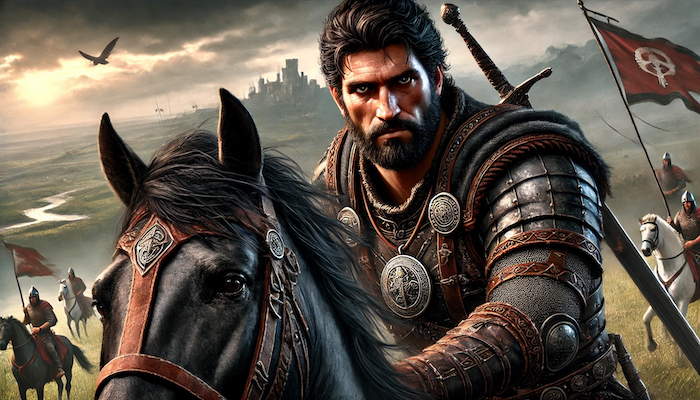The year is roughly 700 B.C. In a world of warring kingdoms and rising empires, one nomadic group made a name for themselves as an unstoppable force: the Cimmerians.
Known as “Gimirri” by the Assyrians, these warriors struck fear into the hearts of kings, from Urartu to Phrygia. But who were the Cimmerians, and how did they become one of the most intimidating enemies of their time?
Origins of the Cimmerians
The Cimmerians were a nomadic people whose origins trace back to the steppes north of the Caucasus Mountains, near the Black Sea. Ancient historians, such as Herodotus, suggest they were pushed southward by the Scythians, another powerful nomadic group, in a wave of migration that disrupted the political landscape of the Near East.
Their name, “Cimmerian,” is derived from Greek sources, but the Assyrians referred to them as “Gimirri.” This term appears in inscriptions from the reign of King Sargon II of Assyria (who was featured prominently in The Curse of King Midas, Book I in The Midas Legacy), where they are described as a marauding and destructive force.
Their mobility, thanks to their mastery of horseback riding and archery, allowed them to launch rapid and devastating raids that left kingdoms scrambling to defend their borders.
The Cimmerians vs. Urartu
The Cimmerians’ first major clash in recorded history was with the kingdom of Urartu (modern-day northeastern Turkey). Urartu, a powerful state at the time, found itself under relentless pressure from these nomads. (If you have a copy of Book I in The Midas Legacy, you’ll see Urartu in the map toward the beginning.)
The Cimmerians’ hit-and-run tactics were devastating, and their ability to traverse difficult terrain made them nearly impossible to corner. Despite Urartu’s fortified cities and mountain strongholds, the Cimmerians managed to disrupt trade routes, plunder settlements, and weaken the kingdom’s defenses.
This conflict with Urartu marked the beginning of the Cimmerians’ rise as a dominant force in the region. Their success in the mountains of Urartu emboldened them, and they turned their attention to larger prizes further south.
The Cimmerians and King Sargon II of Assyria
At the height of their power, the Cimmerians clashed with Assyria, one of the most formidable empires of the ancient world. Under the rule of King Sargon II, Assyria had expanded its borders significantly, establishing itself as a dominant force in Mesopotamia.
However, even the mighty Assyrians were not immune to the Cimmerians’ wrath.
Sargon II’s reign saw the Cimmerians encroaching on Assyrian territory. The Assyrians referred to them as “barbarians” who were difficult to track and nearly impossible to defeat in open battle. Inscriptions from this time describe the Gimirri as a significant threat to Assyrian provinces in the north.
Sargon defeated the Cimmerians once, but in 705 B.C., during another battle with them, he was killed. Details of the battle remain murky, but his death marked a turning point for Assyria and cemented the Cimmerians’ reputation as a force capable of toppling even the greatest kings.
Why Did the Cimmerians Turn to Phrygia?
After their victory over Sargon II, the Cimmerians continued their southward and westward push. Phrygia, ruled by the legendary King Midas, became their next target.
Why? There are several likely reasons:
- Wealth: Phrygia was known for its prosperity, particularly its capital, Gordium, which was a center of trade and culture. For a nomadic group reliant on plunder, the riches of Phrygia were a tempting prize.
- Strategic Location: Phrygia’s position in Anatolia made it a gateway to other regions, particularly Lydia and Greece to the west. Controlling Phrygia would have given the Cimmerians access to new territories to raid and conquer.
- Power Dynamics: By this time, the Scythians had solidified their control over the northern steppes, pushing the Cimmerians into new territories. Their westward movement into Phrygia was as much a necessity as it was a choice.
Phrygia, despite its wealth, was ill-prepared for the Cimmerians’ ferocity. What happened to the kingdom and its popular leader, King Midas? I encourage you to check out my new book, The Gimirri Invasion (Book II in The Midas Legacy) when it comes out in June 2025!
The Cimmerians in “The Gimirri Invasion”
In my upcoming novel, The Gimirri Invasion, the fierce Gimirri warriors play a pivotal role in the story. Drawing inspiration from their historical raids, I’ve reimagined their assault on Phrygia as a brutal and complex campaign tied to both mortal ambition and divine manipulation.
Princess Zoe, daughter of King Midas, must confront not only the physical threat of the Gimirri but also the deeper forces at work. As the Gimirri march on Gordium, their true intentions remain shrouded in mystery. What drives them? Is it merely conquest, or are they pawns in a larger, more dangerous game?
Meanwhile, King Midas, paralyzed by grief after the loss of his son, Prince Anchurus (detailed in Book I, The Curse of King Midas), struggles to rise to the challenge. As the once-golden king falters, the fate of Phrygia falls to those around him—Zoe, his sister Elanur, his loyal advisors Aster and Xander, and the few allies willing to stand against the tide of destruction.
The Cimmerians’ invasion of Gordium sets the stage for a tale of myth, might, and sacrifice. What will happen when their forces clash with the kingdom’s last defenses? And how will the gods—particularly Denisia and Katiah—shape the outcome of this war?
Stay tuned for The Gimirri Invasion to find out what happens when one of history’s most feared groups collides with the mythic world of Phrygia!
P.S. If you’d like to help support the production of this book, click here to donate to the creation of the professional cover! Each level of support comes with exclusive rewards.

